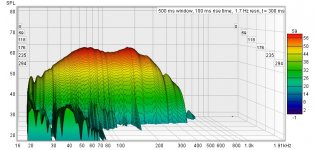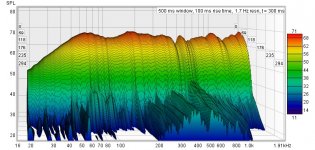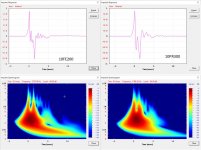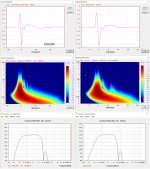Isn't transient response related to frequency response? If they have the exact same frequency response they will automatically have the same transient response......
Can excess phase still apply/exist in a single driver in bandpass configuration? Where does this excess phase come from?
I'm as curious as you, but my question was regarding an internal reflection. Say it involved the port and the front driver cavity, there may be some delayed sound..
The PR is smoother above 200 Hz. Its ripple fits well within adjacent 1 db lines. The FE's ripple peaks go outside the 1 db lines. Its a small difference but it is a difference. I would also be interested in comparing the equalization filter curves to see where and how much each driver needed help.
I would ask for a 2-tone test were it not for your comments about the nature of the difference in sound; it didn't sound like an IM thing.
Do you see a difference in FR at high SPL vs low SPL? Any sign of compression with either driver?
I would ask for a 2-tone test were it not for your comments about the nature of the difference in sound; it didn't sound like an IM thing.
Do you see a difference in FR at high SPL vs low SPL? Any sign of compression with either driver?
Hi guys, sorry to disappear. I found i had forgot to short the coax CD sections when making the measurements, so i'm redoing them.
Shouldn't change things much, but given the kind attention folks are giving to helping, i want to provide best info i can.
Rob Wells, pls feel free to post any waterfalls. And i agree there appears there is some pulsing going on in mine.
Wesayso, I'll change the window times next set.
AllenB, i'm thinking internal reflections too...especially after noticing how fast 2nd and 3rd THD rise once above about 80dB SPL @ 1m.
Checking driver excursion clearances routed in for, before remeasuring.
nc535, checking freq response at higher levels to help check any potential excursion clearance or other issues
Mlee, totally agree, freq and phase response = transient response imu (in my understanding 😉 i guess the question is, is how accurate is the freq response measurements we get from our fft measurements....how much THD etc is aggregated in to the curves we get
thx all, will get new meas up asap
Shouldn't change things much, but given the kind attention folks are giving to helping, i want to provide best info i can.
Rob Wells, pls feel free to post any waterfalls. And i agree there appears there is some pulsing going on in mine.
Wesayso, I'll change the window times next set.
AllenB, i'm thinking internal reflections too...especially after noticing how fast 2nd and 3rd THD rise once above about 80dB SPL @ 1m.
Checking driver excursion clearances routed in for, before remeasuring.
nc535, checking freq response at higher levels to help check any potential excursion clearance or other issues
Mlee, totally agree, freq and phase response = transient response imu (in my understanding 😉 i guess the question is, is how accurate is the freq response measurements we get from our fft measurements....how much THD etc is aggregated in to the curves we get
thx all, will get new meas up asap
Pair of lab12's on a 50x50 MEH on their own, with a lowpass @250 and a couple of PEQ's to make 'flat enough to have a quick listen'
Also a plot with the mids / tweet included.
The waterfall seems to decay pretty smoothly until it hits the background noise. Again, I'm not a measurement guru so make of these graphs what you will 😱
My lab12's were not rear ported and made the front ports chuff at fairly low volumes. (probably due to me eq'ing up the 50Hz region 😀 )
Bear in mind these were quick measurements in the garden to get a basic 'will it won't it work' measurement sweep and a quick listen to a couple of tracks.
Cheers,
Rob.
Also a plot with the mids / tweet included.
The waterfall seems to decay pretty smoothly until it hits the background noise. Again, I'm not a measurement guru so make of these graphs what you will 😱
My lab12's were not rear ported and made the front ports chuff at fairly low volumes. (probably due to me eq'ing up the 50Hz region 😀 )
Bear in mind these were quick measurements in the garden to get a basic 'will it won't it work' measurement sweep and a quick listen to a couple of tracks.
Cheers,
Rob.
Attachments
It seems to me those two drivers are going to have very different Qs in the same enclosure. Q is a measure of damping but it also implies a frequency response - specifically the amount of peaking in the FR. So when they are equalized to the same frequency response do they have the same damping? I've always wondered about that. From what Mark hears and says, apparently not! The 10FE will have a Q of .7 in about 80L. The 10PR will have a Q of .7 in about 8L so it will likely be very highly damped in a box designed for the 10FE200.
The main thing I see is I lost my bet that the weaker motor/larger cavity would show longer decay times, unless shorting the coax CD sections reveals a difference 😱 .I can't see any differences worth noting, other than maybe a bit more 2nd and less 3rd harmonic out of the 10PR300 ...????
They look damn near identical to me.....
But I'm not all that versed in reading waterfalls...anybody see anything?
But the idea the sound diff is about transient response still smells right i think..
I'm not holding my breath for that to make a change in the pass band...
Last edited:
The PR is smoother above 200 Hz. Its ripple fits well within adjacent 1 db lines. The FE's ripple peaks go outside the 1 db lines. Its a small difference but it is a difference.
I think nc535 might have a point and there might be the reason for cardboard resonances here. My highly subjective experience has been that at least with FIR filtering, changes of half a decibel over an octave can be audible, if only just. There is even smaller difference here, and I'm not sure how big of a difference you are actually hearing, but at least I would probably try half a decibel notch @ 320 hz with a Q of 1 or even slightly lower. Would recommend a somewhat blind test afterwards though because once heard problem will manifest itself again and again until one overcompensates.
Last edited:
well its kind of a Sherlock Holmes thing - when you have eliminated all the alternative explanations, the only one that remains must be it. I posted two possibilities so I'm not there yet and I find it hard to believe that such a small difference in measurement would account for a large subjective difference.
I've since done some HR and neither driver's unequalized response seems to change signficantly with rear chamber volume; they seem to be dominated by the horn. Its hard to choose between the two based on frequency response except for 10PR's ~3db higher sensitivity above 120 Hz. But the IRs and IR spectrogram do show differences that imply the 10PR300 has higher damping and would have better transient response. The orange tail of the 10FE's response extends to 10 ms; that of the 10PR ends at 5 ms
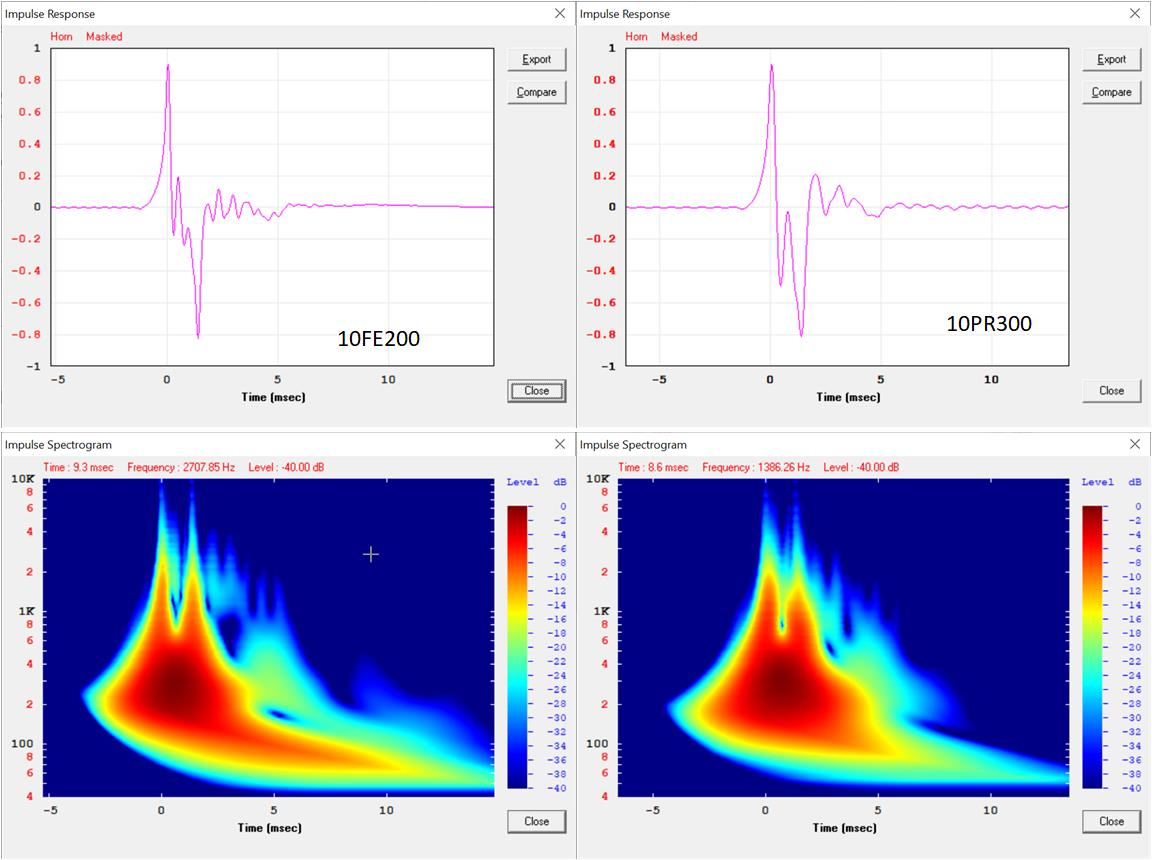
I've since done some HR and neither driver's unequalized response seems to change signficantly with rear chamber volume; they seem to be dominated by the horn. Its hard to choose between the two based on frequency response except for 10PR's ~3db higher sensitivity above 120 Hz. But the IRs and IR spectrogram do show differences that imply the 10PR300 has higher damping and would have better transient response. The orange tail of the 10FE's response extends to 10 ms; that of the 10PR ends at 5 ms
Attachments
Last edited:
Mark
Just a silly question: You didn't forget to adapt the level for the 10" according to their differences in efficiency when you were doing your listening comparisons ?
Regards
Charles
Just a silly question: You didn't forget to adapt the level for the 10" according to their differences in efficiency when you were doing your listening comparisons ?
Regards
Charles
The 10FE200 has a weaker motor and a lower moving mass, which implies a thinner cone (winding depths are very similar, although the wire thickness is unknown).
Under high-pressure loading, I'd expect the cone to flex a little, effectively soft-clipping the waveform in a symmetrical way. Symmetry implies odd-order harmonics, which are seen in the distortion charts - the 10FE200 has higher 3rd harmonic than the 10PR300.
There's another factor pointing in this general direction: soft cones tend to be very benign as they get towards the top of their operating range.
Here's the 10PR300:
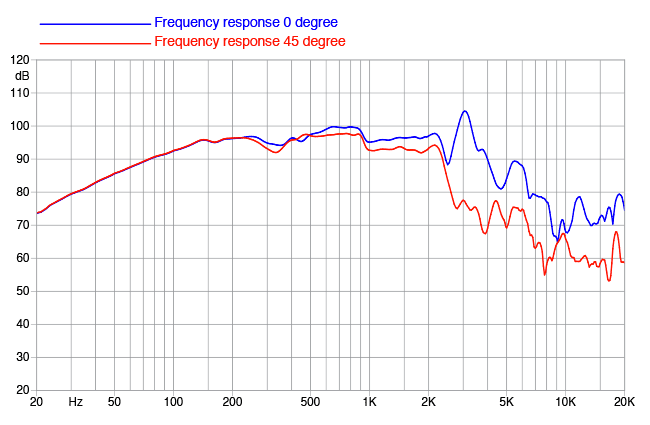
And here's the 10FE200:
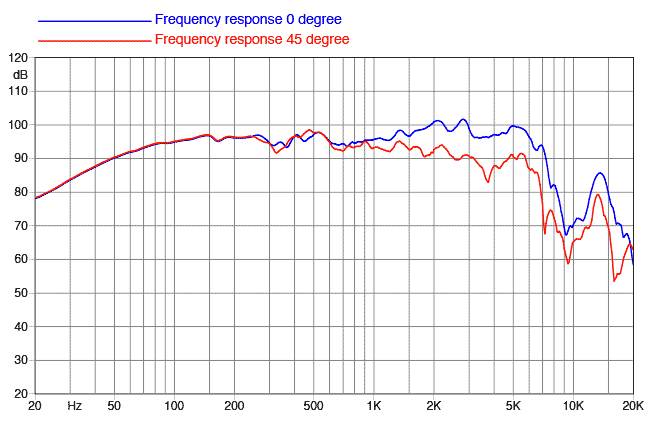
I don't think there's any doubt that the 10FE200 has a much smoother kHz+ range.
For comparison, here's a 10" aluminium-coned Seas driver:

We can see that the more rigid the radiating surface, the higher-Q the resonances. This lends weight to the hypothesis that the 10PR300 simply has a more rigid cone, and, based on Mark's impressions of the sound, that makes it more suitable for high-pressure loading situations.
Chris
Under high-pressure loading, I'd expect the cone to flex a little, effectively soft-clipping the waveform in a symmetrical way. Symmetry implies odd-order harmonics, which are seen in the distortion charts - the 10FE200 has higher 3rd harmonic than the 10PR300.
There's another factor pointing in this general direction: soft cones tend to be very benign as they get towards the top of their operating range.
Here's the 10PR300:

And here's the 10FE200:

I don't think there's any doubt that the 10FE200 has a much smoother kHz+ range.
For comparison, here's a 10" aluminium-coned Seas driver:

We can see that the more rigid the radiating surface, the higher-Q the resonances. This lends weight to the hypothesis that the 10PR300 simply has a more rigid cone, and, based on Mark's impressions of the sound, that makes it more suitable for high-pressure loading situations.
Chris
Pair of lab12's on a 50x50 MEH on their own, with a lowpass @250 and a couple of PEQ's to make 'flat enough to have a quick listen'
Also a plot with the mids / tweet included.
The waterfall seems to decay pretty smoothly until it hits the background noise. Again, I'm not a measurement guru so make of these graphs what you will 😱
My lab12's were not rear ported and made the front ports chuff at fairly low volumes. (probably due to me eq'ing up the 50Hz region 😀 )
Bear in mind these were quick measurements in the garden to get a basic 'will it won't it work' measurement sweep and a quick listen to a couple of tracks.
Cheers,
Rob.
Nice Rob, thx for posting. Looks like things are proceeding well with your build.
It seems to me those two drivers are going to have very different Qs in the same enclosure. Q is a measure of damping but it also implies a frequency response - specifically the amount of peaking in the FR. So when they are equalized to the same frequency response do they have the same damping? I've always wondered about that. From what Mark hears and says, apparently not! The 10FE will have a Q of .7 in about 80L. The 10PR will have a Q of .7 in about 8L so it will likely be very highly damped in a box designed for the 10FE200.
I'm estimating the net enclosed volume at about 10 liters, which would be the same for both drivers, other than their 1/2 liter volume diff.
The main thing I see is I lost my bet that the weaker motor/larger cavity would show longer decay times, unless shorting the coax CD sections reveals a difference 😱 .
I'm not holding my breath for that to make a change in the pass band...
The real reason i wanted to short the CD sections was more about checking what effect, if any, it might have on the distortion or waterfall plots.
Very curiously, shorting changed the look of the pr300's distortion a fair amount, while not doing much for the fe200.
About to post the plots...
I think nc535 might have a point and there might be the reason for cardboard resonances here. My highly subjective experience has been that at least with FIR filtering, changes of half a decibel over an octave can be audible, if only just. There is even smaller difference here, and I'm not sure how big of a difference you are actually hearing, but at least I would probably try half a decibel notch @ 320 hz with a Q of 1 or even slightly lower. Would recommend a somewhat blind test afterwards though because once heard problem will manifest itself again and again until one overcompensates.
I agree with your highly subjective experience regarding small decibel changes being sometimes audible with precise FIR work.
The admittedly subjective difference I believe I'm hearing doesn't really sound like a frequency change, or tonal shift...it sounds more like a cardboardy thuddish sound, coming from the bottom of the fe200's response on transients (somewhere north of 100Hz).
I'm sure I don't need a blind test for it...as i lived with it, hunted for it, over a period of weeks, trying different tunings etc, both indoors and out.
Like i mentioned before, until i swapped to the pr300's, my biggest suspect was the secondary flares made out of foamboard.
However, when I equalize to approximately the same responses, the differences in IR go away. Any residual difference is because the FRs aren't identical.
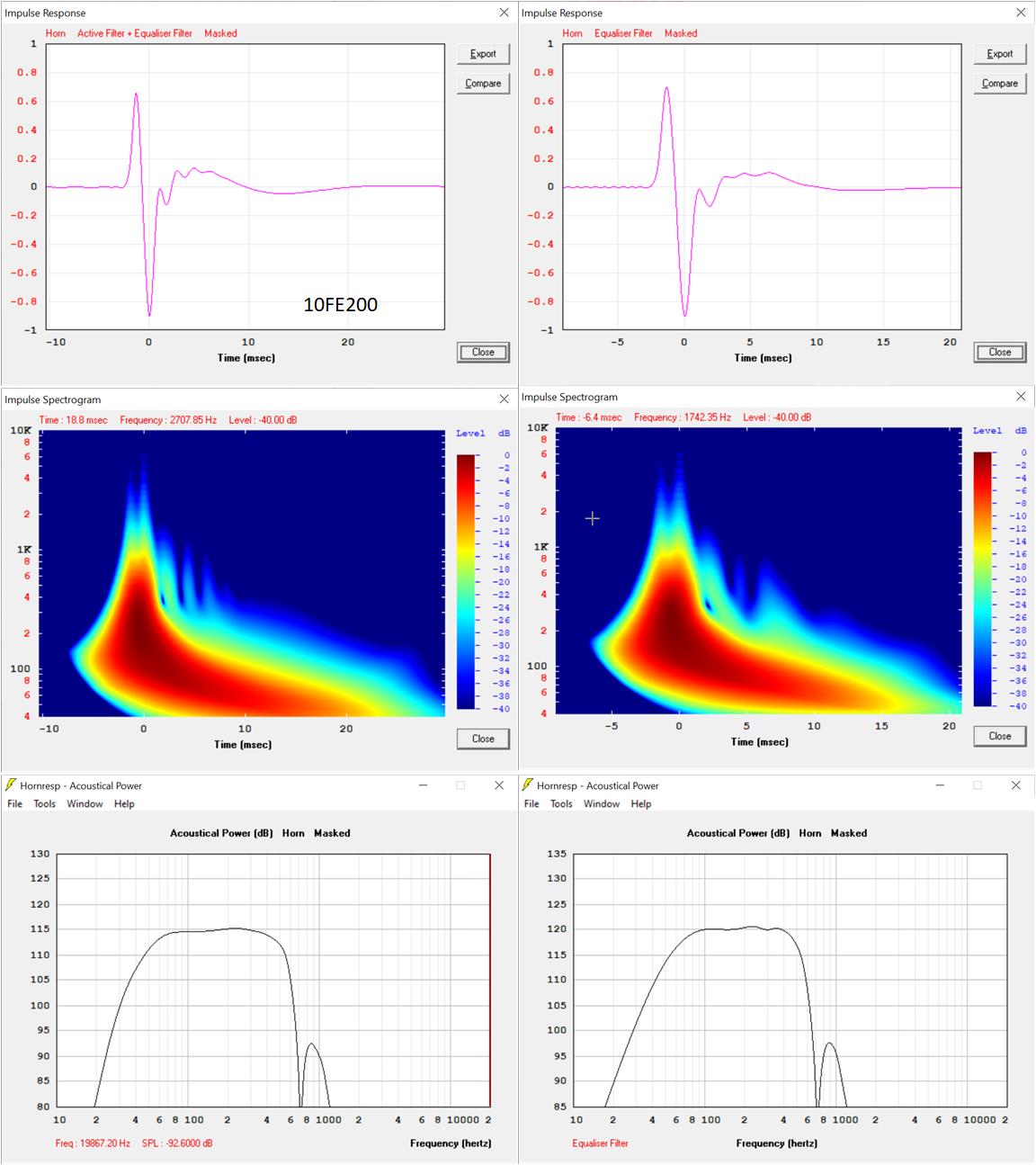
The damping hypothesis remains unproven.
Good stuff Jack, thx.
Have your sims been factoring in the 10:1 compression ratio?
The port is fairly well centered under the driver.
Mark
Just a silly question: You didn't forget to adapt the level for the 10" according to their differences in efficiency when you were doing your listening comparisons ?
Regards
Charles
Hi Charles, always a fair question 🙂
Quick answer is yes.
But due to a series of Parts Express screw ups in sending me the right ohm drivers, the 10fe200s have been two 4 ohms in series (meant to have two 8 ohm in parallel. The pr300's are two 8 ohm in parallel.
Since the coax CD tuning never changes, i just use it's lower section level as the reference level to match the mids to, as i swap mid drivers.
Easy peasy to get dead on.
- Home
- Loudspeakers
- Multi-Way
- A case where measurements go ????
